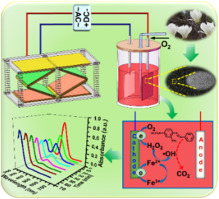Nano Energy ( IF 17.6 ) Pub Date : 2017-11-04 , DOI: 10.1016/j.nanoen.2017.10.060 Ye Chen , Miao Wang , Miao Tian , Yingzheng Zhu , Xianjun Wei , Tao Jiang , Shuyan Gao

|
Based on the advantages of electro-Fenton (EF) and our works on the flexible design of triboelectric nanogenerator (TENG) and biomass carbon materials, a self-powered EF system is demonstrated. It is driven by a robust and flexible multilayered TENG (RFM-TENG) using carbon materials derived from magnolia flowers as the cathode for oxygen reduction. The synthetic mesoporous carbon materials have a large surface area (1226 m2 g−1), favoring dissolved oxygen mass transfer and promoting the oxygen reduction process. With the sponge as the buffer layer and pre-charge injection, the short-circuit current, transferred charge and open-circuit voltage of RFM-TENG are 960 μA, 2.8 μC and 1050 V, respectively, and the maximum power density reaches 5.5 W m−2 at a load resistance of 1 MΩ. Driven by this RFM-TENG, the persistent organic pollutant, basic orange 2, can be degraded to CO2 by hydroxyl radical (•OH) generated during EF process. Such mechanism is proposed based on the cyclic voltammogram, gas chromatograph-mass spectrometer, UV−vis spectra and the H2O2 measurement. With compelling features of the efficient EF method, versatile TENG and biomass-derived carbon materials, this work pioneers the alliance of TENG, carbon-based electrodes and EF to self-power the organic pollutants degradation for sustainable environmental protection.
中文翻译:

利用生物质衍生的碳材料作为阴极催化剂的摩擦电纳米发电机自供电的创新型电子芬顿降解系统
基于电子芬顿(EF)的优势以及我们对摩擦电纳米发电机(TENG)和生物质碳材料的灵活设计工作,展示了一种自供电的EF系统。它是由坚固而灵活的多层TENG(RFM-TENG)驱动的,它使用源自木兰花的碳材料作为氧还原的阴极。合成的中孔碳材料具有大的表面积(1226m 2 g -1),有利于溶解氧的质量传递并促进了氧的还原过程。以海绵作为缓冲层并进行预充电注入,RFM-TENG的短路电流,转移的电荷和开路电压分别为960μA,2.8μC和1050 V,最大功率密度达到5.5 W m -2在1MΩ的负载电阻下。在此RFM-TENG的驱动下,持久性有机污染物碱性橙2可以被EF过程中产生的羟基自由基(•OH)降解为CO 2。基于循环伏安法,气相色谱-质谱仪,UV-vis光谱和H 2 O 2测量,提出了这种机理。凭借高效的EF方法,通用的TENG和源自生物质的碳材料的引人注目的功能,这项工作开创了TENG,碳基电极和EF的联盟,以自给自足地降解有机污染物,以实现可持续的环境保护。


























 京公网安备 11010802027423号
京公网安备 11010802027423号